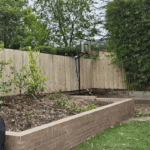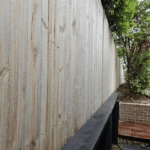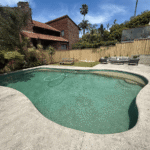Lapped and capped fences pros
Lapped and capped fences
In the realm of fencing options, where function meets form, lapped and capped fences have carved a niche for themselves as an enduring choice that marries aesthetic appeal with practical advantages. With a design that boasts overlapping wooden boards and a horizontal cap at the top, these fences offer more than just a barrier. they bring a touch of elegance and a slew of benefits to properties. In this blog post, we will delve into the 800-word exploration of the numerous advantages that make lapped and capped fences a popular choice for homeowners and property managers alike.
Aesthetic Elegance
Lapped and capped fences stand as a testament to the timeless allure of classic design. The overlapping boards not only create a sense of depth and dimension but also imbue the fence with a rhythm. This aesthetic appeal can seamlessly complement various architectural style.
Privacy and Security Amplified
One of the foremost advantages of lapped and capped fences lies in their ability to provide enhanced privacy and security. The cleverly overlapped boards create a solid barrier that minimizes visibility from the outside. Whether you’re enjoying a backyard barbecue with family or relishing a quiet evening on the porch, these fences offer a sense of seclusion, making your outdoor spaces truly your own.
Durability Beyond the Norm
Durability is a hallmark of these fences. By virtue of the overlapping design, these fences are better equipped to withstand the harsh elements of nature. The lap ensures that the wood is shielded from direct exposure to rain, snow, and intense sunlight, reducing the risks of warping and rotting. This translates to a longer lifespan for your fence, resulting in reduced maintenance and replacement costs over time.
Stability in the Face of Adversity
When it comes to stability, lapped and capped fences emerge as a sturdy option. The overlapping boards add an extra layer of reinforcement to the structure. it enables it to withstand the forces of nature more effectively. From gusty winds to unexpected impacts, these fences stand strong, offering you peace of mind that your property is well-protected.
Versatility That Fits Any Setting
The versatility of lapped and capped fences is truly noteworthy. They effortlessly adapt to a variety of settings, whether it’s a charming suburban residence or a bustling commercial space. Their design is equally at home in both urban and rural environments, making them a flexible choice for property owners seeking a blend of style and practicality.
Simple Maintenance, Lasting Beauty
While every fence requires maintenance, lapped and capped fences simplify the process. The overlapping design minimizes the accumulation of debris and dirt between the boards, making cleaning a less arduous task. With regular care, these fences retain their pristine appearance for years to come. it ensures that your property maintains its allure.
Customization Tailored to You
Personalization takes center stage with lapped and capped fences. Whether you’re aiming for a specific board spacing or height these fences can be tailored to your unique preferences. This flexibility allows you to curate a fence that perfectly aligns with the overall aesthetics of your property.
Reducing Noise, Enhancing Serenity
The overlapping boards of lapped and capped fences serve as a natural barrier that can dampen sound to a certain extent. This feature is especially advantageous if you’re seeking to reduce noise from nearby roads or neighboring properties. By creating a more tranquil outdoor environment, these fences contribute to a peaceful and relaxing atmosphere.
Adding Value, Making a Statement
A well-crafted lapped and capped fence is an investment that pays dividends. Not only does it augment the curb appeal of your property, but it can also enhance its overall value. Prospective buyers and tenants are likely to be drawn to the charm and functionality of these fences. making them a strategic addition for those looking to make a statement in the real estate market.
In the grand tapestry of fencing options, lapped and capped fences stand as a timeless masterpiece. weaving together aesthetic elegance with practical advantages. From their ability to provide heightened privacy and security to their durability and versatility, these fences are a testament to the harmonious convergence of form and function. As you contemplate fencing solutions for your property, consider the enduring allure and manifold benefits of lapped and capped fences—a choice that promises both lasting beauty and practicality.
Get a quote for more information
Dog-Friendly Fence: A Perfect Balance of Safety and Playfulness
Choose a dog friendly fence
As a proud dog owner, you know that your furry friend deserves a safe and secure outdoor space to roam, play, and explore. Designing a dog-friendly fence is not just about practicality; it’s about creating a haven where your canine companion can thrive while offering you peace of mind. In this blog, we’ll delve into the key aspects of designing a fence in sydney that strikes the perfect balance between safety and playfulness for your beloved dog.
Height and Containment: Keeping Your Pup Safe
One of the primary purposes of a dog-friendly fence in sydney is to ensure the safety of your furry friend. Dogs are known for their curiosity and agility, so it’s crucial to choose a fence that provides adequate containment. The fence’s height plays a significant role in preventing your dog from jumping over and exploring the outside world unsupervised.
For smaller dog breeds, a fence with a height of around 4 to 5 feet might suffice, but for larger and more active breeds, a taller fence of 6 feet or more may be necessary. Remember that every dog is unique, so assess your dog’s ability to jump or climb and choose the fence height accordingly.
Materials and Visibility: Balancing Security and Interaction
While security is paramount, it’s equally important to allow your dog to engage with their surroundings and interact with passersby. Solid fences might create a sense of isolation for your dog, leading to boredom and even anxiety. Consider using materials that provide both security and visibility, such as picket fences with spacing that allows your dog to see what’s happening beyond the fence.
Chain-link fences are another popular option as they offer great visibility, allowing your dog to watch the world go by. However, ensure that the openings in the chain-link are small enough to prevent your dog from squeezing through.
Avoiding Escape Routes: Digging and Gaps
Dogs are notorious for finding ingenious ways to escape, including digging under fences or slipping through gaps. To prevent this, consider reinforcing the base of the fence with materials like gravel, concrete, or even buried chicken wire to deter digging.
Inspect the fence regularly for any gaps, loose boards, or weak spots that your dog might exploit. Regular maintenance will ensure that your dog’s environment remains secure and prevent any potential escape routes from developing.
Add Playful Features: Doggy Windows and Access Points
Why not make the fence itself an exciting feature for your dog? Consider incorporating “doggy windows” into your fence – these are openings at your dog’s eye level that allow them to observe the outside world. It’s a great way to keep your dog entertained while satisfying their natural curiosity.
Another idea is to incorporate dog-friendly access points, such as a small doggy door integrated into the fence. This door can lead to a designated play area, allowing your dog to move freely between indoor and outdoor spaces.
Designing a dog-friendly fence requires careful consideration of your dog’s safety, needs, and behavior. Striking the right balance between security and interaction is essential to creating a space where your furry friend can enjoy the outdoors without compromising their well-being. By selecting the appropriate fence height, materials, and features, you can provide your dog with a safe and playful environment that enhances both their quality of life and your peace of mind.
If you need to consult in this case, our team is so proud of helping you in fences. contact us
Some tips to clean a vinyl fence
Vinyl fence
Vinyl fences have become increasingly popular due to their durability, low maintenance requirements, and aesthetic appeal. However, just like any outdoor structure, a vinyl fence also require regular cleaning to keep them looking their best and to extend their lifespan. In this blog, we will provide you with a step-by-step guide on how to effectively clean your vinyl fence and maintain its pristine condition.
Step 1: Gather Your Supplies
Before you start the cleaning process, gather the necessary supplies:
- Mild dish soap or vinyl fence cleaner
- Water hose or pressure washer (with a low-pressure nozzle)
- Soft-bristle brush or cloth
- Bucket
- Garden gloves
- Clean, dry towels or rags
Step 2: Clear the Area and Pre-Rinse
Start by clearing the area around the vinyl fence to ensure easy access. Remove any debris, plants, or obstacles that could obstruct the cleaning process. Then, give your fence a thorough pre-rinse using a water hose or pressure washer on a low-pressure setting. This will help remove loose dirt, dust, and cobwebs.
Step 3: Prepare the Cleaning Solution
Fill a bucket with warm water and add a small amount of mild dish soap or a vinyl fence cleaner. Be cautious not to use abrasive or harsh chemicals, as they can damage the vinyl surface over time. Mix the solution gently until it’s well-dissolved.
Step 4: Scrub Gently
Dip a soft-bristle brush or a cloth into the soapy water solution and start scrubbing the vinyl fence panels. Work in small sections, applying gentle pressure to remove dirt, grime, and stains. If you encounter stubborn spots, you can use a bit more pressure, but avoid excessive force that could scratch the surface.
Step 5: Rinse Thoroughly
After scrubbing a section, rinse it thoroughly with clean water using the hose or pressure washer. Make sure all the soap residue is removed, as it can attract more dirt if left behind. Always rinse from top to bottom to prevent streaking.
Step 6: Address Mold and Mildew
Vinyl fences, especially in humid climates, are susceptible to mold and mildew growth. If you notice any mold or mildew spots, mix a solution of one part water and one part white vinegar. Apply the solution to the affected areas and let it sit for a few minutes. Then, gently scrub the spots with a soft brush or cloth. Rinse with clean water to remove the vinegar solution.
Step 7: Dry the Fence
Use clean, dry towels or rags to wipe down the vinyl fence panels. This will help prevent water spots and promote a streak-free finish.
Step 8: Inspect for Damages
While cleaning your vinyl fence, take the opportunity to inspect it for any damages or issues. Look for cracks, chips, loose sections, or any signs of wear. Addressing these problems promptly can prevent them from worsening over time.
Step 9: Apply Vinyl Protectant (Optional)
Once your vinyl fence is clean and dry, you have the option to apply a vinyl protectant or UV-resistant spray. These products can help protect the fence from fading, discoloration, and other environmental factors. Always follow the manufacturer’s instructions when applying any type of protectant.
Step 10: Regular Maintenance
To keep your vinyl fence looking its best, establish a regular maintenance routine. Lightly rinse it with water every few weeks to remove dust and debris. Address any stains or spots promptly to prevent them from becoming permanent.
Cleaning and maintaining your vinyl fence doesn’t have to be a daunting task. With the right tools and a little effort, you can keep your fence looking beautiful for years to come. Remember to use gentle cleaning methods, avoid abrasive chemicals, and perform regular inspections to catch any issues early. By following these steps, you’ll be able to enjoy the benefits of your vinyl fence’s durability and aesthetic appeal without the hassle of extensive maintenance.
Talk to Our Team for Repairs
If some of your vinyl fencing panels are beyond being able to be cleaned or if you have noticed cracks or damage, you may need a fence repair. Our crew not only installs new fencing, but also repairs our fencing we’ve installed as well. Our team can review your project and offer an estimate. Contact us through our online contact form.
Wood fence maintenance tips
Keeping Your Investment Beautiful and Durable
A wood fence can add charm, privacy, and value to your property. However, to ensure that it remains in good condition and retains its beauty for years to come, regular maintenance is essential. In this blog, we’ll discuss some practical wood fence maintenance tips that will help you keep your investment looking great and standing strong against the elements.
-
Inspect Regularly
Regular inspections are the foundation of proper wood fence maintenance. Check your fence at least once a year for signs of damage, rot, or wear. Look for loose boards, split wood, protruding nails, or any other issues that may compromise the fence’s structural integrity. Early detection of problems allows for timely repairs, preventing small issues from escalating into major concerns.

-
Clean the Fence
Cleaning your wood fence is a crucial maintenance step. Dirt, debris, and mildew can accumulate on the surface over time, making the fence look dull and unattractive. To clean the fence, start by using a hose to rinse off loose dirt and grime. Then, you can use a mixture of mild detergent and water with a soft-bristled brush to scrub away stubborn stains. Rinse thoroughly with clean water to avoid leaving any soapy residue.
-
Apply Sealant or Stain
Sealing or staining your wood fence is vital for its protection against moisture and UV rays. Both sealants and stains create a protective barrier that helps prevent water penetration, which can lead to rot and decay. They also add a layer of UV resistance, preventing the sun from fading the wood’s natural color. Consider applying a new coat of sealant or stain every 2-3 years to keep your fence well-protected and looking fresh.
-
Repair Damaged Areas Promptly
If you spot any signs of damage during your regular inspection, address them promptly. Repair loose or broken boards, and replace any severely damaged or rotted sections. Ignoring small issues can lead to more extensive damage and compromise the fence’s stability. Always use quality materials when making repairs to ensure the longevity of the fence.
-
Trim Vegetation
Vegetation, such as bushes or vines, growing too close to the fence can cause damage over time. The moisture from leaves and branches can promote rot, and the pressure from overgrown vegetation can push on the fence, loosening boards or posts. Keep the area around the fence clear and trim back any vegetation to maintain a safe distance.
-
Proper Drainage
Ensure that your fence has proper drainage to prevent water from pooling around the base. Prolonged exposure to water can weaken the wood and lead to rot. If necessary, regrade the ground around the fence to encourage water to flow away from it.
-
Avoid Direct Contact with Soil
Direct contact with soil can cause the bottom of the fence to decay rapidly. Whenever possible, avoid burying the fence posts directly into the ground. Instead, elevate the fence slightly using concrete footings or metal brackets to keep the wood away from soil contact.
-
Protect Against Pests
Wood is susceptible to pests like termites, carpenter ants, and wood-boring beetles. To protect your fence from infestations, consider treating the wood with an appropriate wood preservative that has insect-repelling properties. Additionally, keep an eye out for any signs of pest activity during your inspections and take appropriate measures if needed.
A well-maintained wood fence can last for decades and enhance the beauty and value of your property. By following these wood fence maintenance tips, you can ensure that your investment remains strong, durable, and aesthetically pleasing for years to come. Regular inspections, cleaning, sealing or staining, and prompt repairs are essential practices that will extend the life of your wood fence, providing you with a charming and functional barrier for your outdoor space.
if you need fence repairing contractor, Contact us as soon as you can.
Why should we repair fences?
Fences are more than just barriers that define property lines; they are an integral part of our homes and surroundings. Over time, fences can face wear and tear due to weather conditions, age, or accidental damage. When left unrepaired, a deteriorating fence can compromise security, diminish the appeal of your property, and eventually lead to costly replacements. In this blog, we will explore the numerous advantages of fence repairing, emphasizing safety, aesthetics, and the longevity of your fence.
- Ensuring Safety and Security
One of the most crucial advantages of fence repairing is the restoration of safety and security to your property. A well-maintained fence acts as a deterrent to potential intruders and keeps unwanted guests at bay. By repairing broken or damaged sections, you strengthen the fence’s integrity, preventing it from being an easy target for trespassers.
For families with children or pets, a properly repaired fence creates a safe environment for them to play outdoors without any risk of wandering into neighboring properties or hazardous areas.
- Preserving Privacy
A fence serves as a shield from prying eyes and maintains the privacy of your home and backyard. However, a damaged fence with gaps or missing panels can compromise your privacy. Repairing your fence ensures that you maintain the solitude you desire, allowing you to enjoy your outdoor spaces without feeling exposed.
- Enhancing Curb Appeal
The appearance of your property plays a significant role in creating a positive impression on visitors and potential buyers. A well-kept fence enhances the curb appeal of your home, making it look more attractive and well-maintained. Whether you have a wooden picket fence or a modern metal design, repairing it will refresh the overall appearance and add value to your property.

- Cost-Effectiveness
Choosing fence repairing over complete replacement can be a cost-effective solution. Repairing specific sections of the fence, such as damaged posts or rails, is often more economical than replacing the entire fence. Additionally, by addressing minor issues promptly, you can prevent them from escalating into more extensive problems that would require more significant investments down the line.
- Extending Fence Lifespan
Regular maintenance and timely repairs can significantly extend the lifespan of your fence. Ignoring small damages can lead to more extensive structural issues, which might necessitate a complete replacement. By promptly addressing issues like loose nails, rotting wood, or rusted metal, you ensure that your fence continues to stand strong for years to come.

- Environmental Benefits
Repairing a fence rather than replacing it is also an environmentally-friendly choice. Opting for fence repair reduces the demand for new materials and minimizes waste generation. By practicing sustainable fence maintenance, you play a part in conserving natural resources and reducing your ecological footprint.
- Legal Compliance
In many areas, there are regulations and guidelines regarding fence height, materials, and appearance. A damaged fence might not comply with local laws and ordinances, putting you at risk of penalties or fines. Repairing your fence ensures that it adheres to these regulations, keeping you in good standing with the authorities.
In conclusion, the advantages of fence repairing go beyond mere aesthetics. Repairing your fence enhances safety, security, and privacy while preserving the overall appeal of your property. Additionally, it offers a cost-effective and environmentally-conscious alternative to complete replacements, helping you extend the lifespan of your fence. Remember, a well-maintained fence not only adds value to your home but also instills a sense of pride in homeownership. So, don’t delay – take the necessary steps to repair your fence and enjoy the benefits it brings for years to come.
Timber fence and its advantages
The Advantages of Timber Fences: A Timeless and Versatile Choice
When it comes to selecting a fence for your property, timber fences have stood the test of time for their natural beauty, durability, and versatility. Timber fences offer numerous advantages that make them a popular choice among homeowners and property developers alike. In this blog, we will explore the benefits of timber fences, from their aesthetic appeal to their environmental sustainability, highlighting why they continue to be a preferred option for fencing projects.
Natural Beauty and Warmth
One of the primary advantages of timber fences is their natural beauty and warmth. The warmth and elegance of wood can enhance the overall aesthetic appeal of any property, complementing both traditional and contemporary architectural styles. Timber fences can be crafted in various designs, allowing homeowners to choose the perfect style that matches their preferences and enhances the curb appeal of their property. Additionally, timber ages gracefully, developing a charming patina over time that adds character and uniqueness to the fence.
Durability and Longevity
Timber fences, when properly maintained, can be highly durable and long-lasting. Hardwood varieties like cedar, redwood, or treated pine offer excellent resistance to decay, insects, and weathering. The natural properties of these woods make them resilient against rotting and warping, ensuring the fence withstands the test of time. Regular maintenance, including staining or painting and applying sealants, can further extend the lifespan of a timber fence, making it a cost-effective investment in the long run.
Versatility and Customization
Timber fences offer unparalleled versatility, allowing for a wide range of customization options. Wood can be easily cut, shaped, and assembled to create fences of various heights, styles, and designs. Whether you prefer a solid privacy fence or an open picket fence, timber can be adapted to suit your specific needs. Additionally, wood can be stained or painted in a spectrum of colors, providing endless possibilities for customization to match your property’s aesthetics and personal preferences.
Environmental Sustainability
In an era of increasing environmental consciousness, timber fences provide an eco-friendly fencing option. Wood is a renewable resource, and responsible forestry practices ensure its sustainability. Additionally, timber fences have a lower carbon footprint compared to alternative fencing materials like PVC or metal. Wood acts as a carbon sink, storing carbon dioxide from the atmosphere, and requires significantly less energy to manufacture compared to other materials. When the lifespan of a timber fence ends, it can be recycled or repurposed, reducing waste and minimizing environmental impact.
Timber fences offer an array of advantages that make them a timeless and versatile choice for property owners. From their natural beauty and warmth to their durability, customization options, and environmental sustainability, timber fences continue to be a popular fencing solution. If you’re looking to enhance the aesthetics, privacy, and security of your property, consider the many benefits that timber fences provide, ensuring a practical and visually appealing solution that will endure for years to come.
- ‹ Previous
- 1
- 2
- 3
- 4




